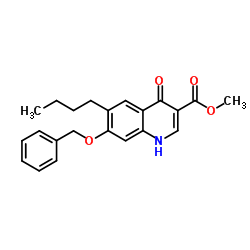Nequinate

Nequinate structure
|
Common Name | Nequinate | ||
|---|---|---|---|---|
| CAS Number | 13997-19-8 | Molecular Weight | 365.422 | |
| Density | 1.2±0.1 g/cm3 | Boiling Point | 520.7±50.0 °C at 760 mmHg | |
| Molecular Formula | C22H23NO4 | Melting Point | 287.5ºC | |
| MSDS | Chinese USA | Flash Point | 268.7±30.1 °C | |
| Symbol |

GHS07 |
Signal Word | Warning | |
Use of NequinateNequinate, a quinoline compound, is an anticoccidial agent against cecal coccidiosis (Eimeria tenella) infections[1]. Nequinate inhibits xanthine oxidoreductase (XOD) activity[2]. |
| Name | Methyl 7-(benzyloxy)-6-butyl-4-oxo-1,4-dihydroquinoline-3-carboxylate |
|---|---|
| Synonym | More Synonyms |
| Description | Nequinate, a quinoline compound, is an anticoccidial agent against cecal coccidiosis (Eimeria tenella) infections[1]. Nequinate inhibits xanthine oxidoreductase (XOD) activity[2]. |
|---|---|
| Related Catalog | |
| In Vitro | Xanthine oxidase (XOD) is a successful and safe drug target for lowering lower serum urate (sUA) levels , it plays an important role in the catabolism of purine Nequinate shows an inhibition of 12.0% to inhibit XOD activities[2]. |
| References |
| Density | 1.2±0.1 g/cm3 |
|---|---|
| Boiling Point | 520.7±50.0 °C at 760 mmHg |
| Melting Point | 287.5ºC |
| Molecular Formula | C22H23NO4 |
| Molecular Weight | 365.422 |
| Flash Point | 268.7±30.1 °C |
| Exact Mass | 365.162720 |
| PSA | 68.39000 |
| LogP | 6.01 |
| Vapour Pressure | 0.0±1.4 mmHg at 25°C |
| Index of Refraction | 1.579 |
| Symbol |

GHS07 |
|---|---|
| Signal Word | Warning |
| Hazard Statements | H302-H413 |
| Personal Protective Equipment | dust mask type N95 (US);Eyeshields;Gloves |
| Hazard Codes | Xn: Harmful; |
| Risk Phrases | R22 |
| RIDADR | NONH for all modes of transport |
| HS Code | 2933499090 |
| HS Code | 2933499090 |
|---|---|
| Summary | 2933499090. other compounds containing in the structure a quinoline or isoquinoline ring-system (whether or not hydrogenated), not further fused. VAT:17.0%. Tax rebate rate:13.0%. . MFN tariff:6.5%. General tariff:20.0% |
|
Comparative efficacy of anticoccidials under the conditions of commercial broiler production and in battery trials.
Vet. Parasitol. 76(3) , 163-71, (1998) Coccidia were isolated from a commercial broiler farm with a history of suspected drug resistance. The sensitivity profiles of the Eimeria spp. isolates against the anticoccidial drugs nicarbazin (NIC... |
|
|
Sensitivity of field isolates of Eimeria tenella to anticoccidial drugs in the chicken.
Res. Vet. Sci. 47(1) , 125-8, (1989) Thirty isolates of Eimeria tenella obtained from broiler and breeder farms were examined for their sensitivity to anticoccidial drugs. All were sensitive to robenidine, 28 were sensitive to methyl ben... |
|
|
Immunity and effect of clopidol/methyl benzoquate and robenidine before and after weaning on rabbit coccidiosis in the field.
Res. Vet. Sci. 35(2) , 211-6, (1983) For 15 months the anticoccidial effect of 200 ppm clopidol/methyl benzoquate and of 50 ppm robenidine, and the development of immunity against five different species of Eimeria were followed in a clos... |
| 7-(Benzyloxy)-6-n-butyl-1,4-dihydro-4-oxo-3-quinolinecarboxylic Acid Methyl Ester |
| 7-(Benzyloxy)-6-n-butyl-3-methoxycarbonyl-4-quinolone |
| nequinate |
| MFCD00867198 |
| methyl 7-(benzyloxy)-6-butyl-4-oxo-1,4-dihydroquinoline-3-carboxylate |
| Methyl 7-(benzyloxy)-6-butyl-4-oxo-1,4-dihydro-3-quinolinecarboxylate |
| EINECS 237-796-6 |
| 3-Quinolinecarboxylic acid, 6-butyl-1,4-dihydro-4-oxo-7-(phenylmethoxy)-, methyl ester |
| 7-(Benzyloxy)-6-n-butyl-4-hydroxy-3-quinolinecarboxylic Acid Methyl Ester |
| 3-Methoxycarbonyl-6-n-butyl-7-benzyloxy-4-oxoquinoline |

